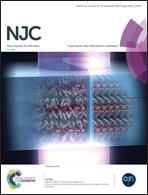Deciphering the role of the head group of cationic surfactants in their binding interactions with heme protein and their release by β-cyclodextrin†
Abstract
A consideration of the physiochemical properties of protein–surfactant interactions is important for understanding their behavior in biological systems. The binding interactions of the different head groups of two cationic surfactants, CTAB and CPC, with heme protein, hemoglobin (Hb), have been extensively divulged through the use of various physicochemical and spectroscopic techniques such as tensiometry, UV-Vis spectroscopy, steady-state fluorometry, time-resolved fluorometry, circular dichroism (CD) spectroscopy, calorimetry, dynamic light scattering (DLS), stopped flow kinetics and cyclic voltammetry at the physiological pH of 7.4 at 298 K. The enthalpy change values of each stepwise addition of surfactant for the binding interaction process with Hb have been obtained through an isothermal titration calorimetric (ITC) study. The surfactant–protein association kinetics have been examined using a stopped flow technique. The binding of surfactant with the protein backbone results in a substantial alteration in the protein’s conformation and causes a denaturation of the protein’s structure. β-Cyclodextrin (β-CD) effectively releases the surfactant from the denatured Hb, thus regaining the native structure of the Hb. A molecular docking study also reveals the role of the head group of the surfactants in their binding interactions with Hb and subsequent release by β-CD.



 Please wait while we load your content...
Please wait while we load your content...